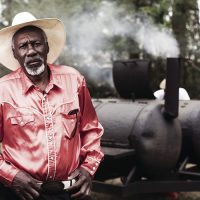A song about not giving up, even when you discover that your woman is cheating, then give her another chance, only to then find out she is still off with this other dude.
And Sam “Lightnin'” Hopkins, as always, did it in just one take — with the money up front.
That was the deal with this Warren’s River bottom, Texas-born blues man, a proposition that gave his recorded legacy both a remarkable depth and a crackling immediacy.
 “Back Door Friend,” loose but foreboding, remains a blues song in the truest, deepest sense of the word — filled with love, longing, and vengeful anger:
“Back Door Friend,” loose but foreboding, remains a blues song in the truest, deepest sense of the word — filled with love, longing, and vengeful anger:
She just praying for you to move out, so her back door friend can move in …
Then later:
Yeah, you know I bought that woman a diamond ring. I thought that she would change. I went home one morn’ and I caught her doing — whoa — that same old thing.
Given his nickname in the late 1940s, during a date with pianist Wilson “Thunder” Smith, Hopkins would eventually record for most of six decades, often for several labels at once — hitting with classics such as “Coffee Blues” and “Mojo Hand.” He then later came to a second career in the folk boom of the 1960s, performing as part of 1964’s American Folk Blues Festival, and toured Japan as late as 1978 before dying of cancer in 1982.
He believed, until the end, in the soul-deep power of the blues: “I’m gonna tell you exactly how it is,” Hopkins said in 1968. “People have learned how to strum a guitar, but they don’t have the soul. They don’t feel it from the heart. It hurts me. I’m killing myself to tell them how it is.”
This recording was made in 1965 for Jewel and Shreveport, La., producer/record-shop legend Stan Lewis, and it’s actually a first-take remake of “Letter To My Back Door Friend,” on ‘Charly Blues Masterworks Vol. 8’ from 1963. Hopkins often played solo, performing his own complex rhythmic accompaniment through a combination of imaginative fingerstyle playing and tapping on the body of his guitar. Here, however, he appears with a backing band, including pianist Elmore Nixon.
Hopkins eventually made three albums for Jewel, the bulk of them at ACA Studios in Houston with Bill Holford as engineer. If the cuts weren’t just right on the initial try, there were no do overs. Informal and unspoiled, no one dared question the blues legend as powerfully personalized tunes like “Back Door Friend” were put on tape back then — and they’d dare even less to speak up now.
Lightnin’ Hopkins didn’t rehearse. A former apprentice with Blind Lemon Jefferson, he didn’t have to. These songs were his life’s story. That, eventually, made Hopkins — one of the critical bridge points between the acoustic and electric styles — a central piece in the style infrastructure of both Jimi Hendrix and Stevie Ray Vaughan.
He influenced musicians as diverse as Ron “Pigpen” McKernan (the early Grateful Dead singer and keyboardist), Townes Van Zandt (fellow Texas folk/blues artist), R.E.M. (their 1987 “Document” album had a tune named after the blues great) and Doyle Bramhall II — who has a tattoo of Hopkins on his left arm.
(This song is not to be confused with Willie Dixon’s “Back Door Man,” later famously remade by the Doors — which is written from the point of view of the cheater. The amazingly prolific Dixon, after all, recorded Hopkins’ “Back Door Friend” in 1952 with Jimmy Rogers.)
- How Deep Cuts on ‘Music From Big Pink’ Underscore the Band’s Triumph - July 31, 2023
- How ‘Islands’ Signaled the Sad End of the Band’s Five-Man Edition - March 15, 2022
- The Band’s ‘Christmas Must Be Tonight’ Remains an Unjustly Overlooked Holiday Classic - December 25, 2016





